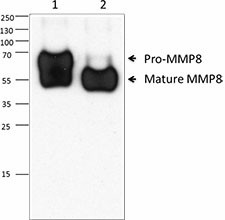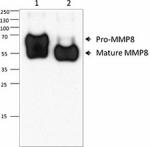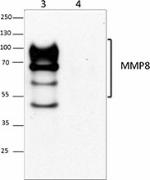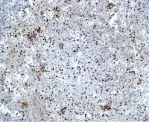- Clone
- 1502022 (See other available formats)
- Regulatory Status
- RUO
- Other Names
- Matrix metallopeptidase 8, CLG1, MMP8, PMN-CL, Neutrophil Collagenase, MMP-8
- Isotype
- Mouse IgG2b, κ
- Ave. Rating
- Submit a Review
- Product Citations
- publications

-

-

Western blot analysis of 50 ng recombinant human MMP8 untreated (lane 1), 50 ng MMP8 activated with 1mM p-aminophenylmercuric acetate (APMA) for 45 minutes (lane 2), 15 µg human Neutrophil (lane 3) and 15 µg mouse bone marrow (lane 4). Purified anti-MMP8 antibody (clone 1502022) was used, followed by HRP anti-mouse IgG antibody. -

IHC staining of purified anti‐MMP8 antibody (clone 1502022) on formalin‐fixed paraffin‐embedded normal human spleen. After antigen retrieval using sodium citrate, the tissue was incubated with the primary antibody at 0.5 µg/ml for 24 hours at 4°C. BioLegend’s Ultra Streptavidin (USA) HRP Detection Kit was used for detection followed by hematoxylin counterstaining.
| Cat # | Size | Price | Quantity Check Availability | Save | ||
|---|---|---|---|---|---|---|
| 688002 | 100 µg | 229 CHF | ||||
MMP-8, also termed neutrophil collagenase, is a member of the matrix metalloproteinase family proteins (MMPs). Members of this family are zinc-containing enzymes that degrade the extracellular matrix (ECM) and connective tissue proteins. Substrates of MMP-8 include type I, II, and III triple-helical collagens, gelatin peptides, proteoglycans, fibronectin, aggrecan, substance P, serpins, β-casein, and angiotensin. MMP-8 is released by neutrophils upon IL-1β, IL-8, GM-CSF and TNF-α stimulation. Besides playing a role in phagocytosis, MMP-8 has been implicated in rheumatoid arthritis (RA) because of its high efficiency in infiltrating connective tissue and breaking down ECM. In fact, serum level of MMP-8 is a strong predictor of mortality in RA, as this is consistent with increased activation of neutrophils in RA. In addition, MMP-8 has been shown to play a crucial role in cardiovascular diseases by promoting atherosclerotic lesion formation. This is supported by the finding that MMP-8 knockout mice have less endothelial cells or plaque angiogenesis in the atherosclerotic plaques. In a clinical study, it was shown that the ratio of MMP-9/TIMP-1, as well as MMP-8 serum levels, could be a useful predictor of prognosis in patients with hepatocellular carcinomas.
Product DetailsProduct Details
- Verified Reactivity
- Human
- Antibody Type
- Monoclonal
- Host Species
- Mouse
- Immunogen
- Human MMP-8, amino acids (Phe21-Gly467) (Accession# NP_002415.1), is expressed with a C-terminal His tag and a linker sequence in 293E cell lines.
- Formulation
- Phosphate-buffered solution, pH 7.2, containing 0.09% sodium azide.
- Preparation
- The antibody was purified by affinity chromatography.
- Concentration
- 0.5 mg/ml
- Storage & Handling
- The antibody solution should be stored undiluted between 2°C and 8°C.
- Application
-
WB - Quality tested
IHC-P - Verified - Recommended Usage
-
Each lot of this antibody is quality control tested by Western blotting. For Western blotting, the suggested use of this reagent is 0.25 - 1.0 µg per ml. For immunohistochemical staining on formalin-fixed paraffin-embedded tissue sections, the suggested use of this reagent is 0.5 - 5.0 µg per ml. It is recommended that the reagent be titrated for optimal performance for each application.
- RRID
-
AB_2617008 (BioLegend Cat. No. 688002)
Antigen Details
- Structure
- 467 amino acids, SDS-PAGE apparent molecular weight of Pro-MMP8 is 65-75 kD and Mature MMP8 is 55-60 kD. Consists of a prodomain that is cleaved upon activation, a catalytic domain, a hinge region and a carboxyl terminal domain with hemopexin-like repeats
- Distribution
-
Neutrophils, macrophages, and monocytes.
- Interaction
- Collagen type I, II, and III, gelatin, proteoglycans, fibronectin, aggrecan, substance P, serpins, ß-casein, and angiotensin.
- Cell Type
- Neutrophils, Macrophages, Monocytes
- Biology Area
- Angiogenesis, Cell Adhesion, Cell Biology, Neuroinflammation, Neuroscience
- Molecular Family
- Enzymes and Regulators
- Antigen References
-
1. Nagase H, Woessner JF Jr. 1999. J. Biol. Chem. 274:21491.
2. Gill SE, Parks WC. 2008. Int. J. Biochem. Cell Biol. 40:1334.
3. Mattey DL, et al. 2012. Arthritis Res. Ther. 14:R204.
4. Fang C, et al. 2013. Cardiovasc. Res. 99:146.
5. Lempinen M, et al. 2013. Ann. Med. 45:482.
6. Sommer K, et al. 2013. PLoS One 8:e73992. - Gene ID
- 4317 View all products for this Gene ID
- UniProt
- View information about MMP-8 on UniProt.org
Related Pages & Pathways
Pages
Related FAQs
Other Formats
View All MMP-8 Reagents Request Custom Conjugation| Description | Clone | Applications |
|---|---|---|
| Purified anti-MMP8 | 1502022 | WB,IHC-P |
Compare Data Across All Formats
This data display is provided for general comparisons between formats.
Your actual data may vary due to variations in samples, target cells, instruments and their settings, staining conditions, and other factors.
If you need assistance with selecting the best format contact our expert technical support team.

 Login / Register
Login / Register 










Follow Us